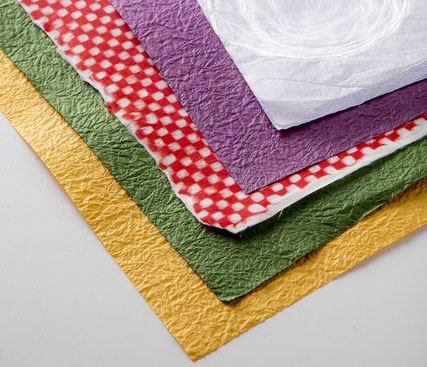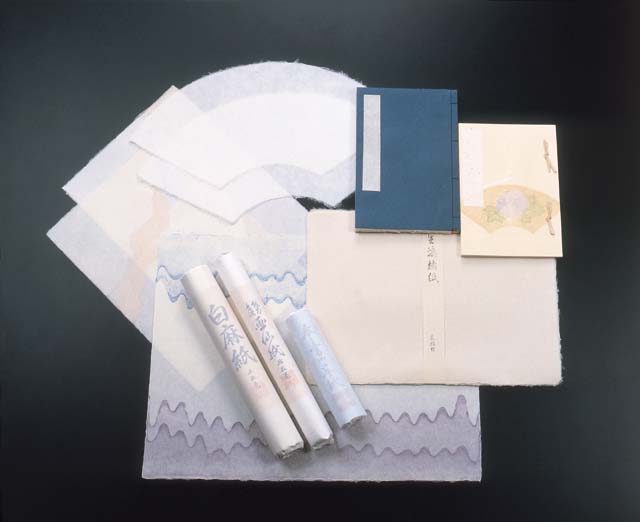
- Traditional Japanese paper
- Fukui
Echizen traditional Japanese paper Echizen washi
Japanese history and tradition
First class quality and exceptional artistry
Description
What is Echizen traditional Japanese paper ?
Echizen washi is a Japanese traditional paper made in the basin of the Okafuto river of the Echizen region, Fukui prefecture. Washi is made mostly from the inner bark fibers of plants such as paper mulberry, paperbush, and ganpi. Echizen washi features elegant and inspiring natural colors and is known for being high quality, resistant to insect damage, and capable of being stored for a long time.
Since paper mulberry has thick long fibers, it can be processed into sturdy papers that are suitable for calligraphy, dolls, and other craft products. Washi made from paperbush has a smooth and slightly glossy texture, therefore it is generally used for traditional sliding doors or printing paper. Since it is very difficult to grow ganpi, people used to collect the plant in the wild instead. Washi made from paper mulberry features fine wrinkles called shibo, which is perfect for producing certificates of merit or the paper used during a tea ceremony. Other than the types mentioned above, there are many varieties of Echizen washi, such as the ceremonial paper used among court nobles, samurai families, and shrines, as well as gift wrapping and certificates.
History

Echizen washi is said to have started no later than the 4th or 5th century when paper was first imported to Japan. The Shosoin Repository* has the oldest preserved manuscript in Japan and it mentions Echizen washi.
The Echizen region is home to the Kami Festival, an intangible folklore cultural asset of Fukui prefecture, in which for centuries people have enshrined the paper god of the Otaki and Okamoto shrines. Initially, Echizen washi had been made for hand copying Buddhist sutras and as court nobles and samurai families began to use more paper, production developed under the protection of the Tokugawa shogunate (feudal military government) and the local lords. High quality products like Echizen ceremonial paper became well known and as papermaking techniques developed, production increased. This industrial success resulted in the creation of a Fukui local paper currency that resembles the currency notes of today. During the Meiji period (1868-1912), paper for the national currency issued by the Grand Council of State (the highest organ of Japan's government at the time) was made in the Fukui region. Also, the Paper Money Office of the National Printing Bureau was established here.
Echizen washi has been steeped in national cultural traditions since ancient times while still having a strong connection with the practical methods used to produce paper currency in Japan. Today, there is a wide variety of products; ranging from everyday use items like small business cards and postcards to traditional and formal items like Echizen ceremonial paper.
*The Shosoin Repository is a building located in Nara, a former capital of Japan, that has been around since the eighth-century. It not only has a collection of treasures dating back to the Silk Road, it also preserves over 10,000 hand-written documents all dating from the Nara period (710–784). Today the repository is under the control of the Imperial Household Agency.
Production Process

- 1. Boiling
The bark of the raw materials like paper mulberry, paperbush, and ganpi is first weighed into batches that are soaked for about ten hours in order to make it softer and easier to boil. A mix of the raw material, water, caustic soda, and soda ash is boiled. Based on the type or combination of raw materials and the usage of the final product, the quantity of soda ash and the boiling time will vary. The boiling process will also make it easier to dissolve impurities in the plant bark such as fat or tannin.
- 2. Cleaning and washing
The bark is washed in water to get rid of impurities dissolved in the boiling process or any dust present in the raw materials. If the washing and cleaning is well done, the quality of the finished paper will be higher. Careful handwork is required to remove any bark that was damaged during the pruning process.
- 3. Beating
The bonded cellulose aggregates of the bark are beaten to break down and soften the fiber tissues. With enough breaking down, the fibers become sticky and help the final product be strong and resistant to tearing or pulling. Traditionally beating was done by hand with a stick and a board, but today a machine is used the majority of the time. The characteristics of each raw material must be taken into account when choosing the most efficent beating method.
- 4. Bleaching
There are times when the natural color of the raw material is preserved in the final product, but in some cases, the sheets may be bleached or colored in accordance with what the final product demands.
- 5. Wooden watertank
Mucus that comes from the roots of the panicled hydrangea or sunset hibiscus is poured into a sukibune or a wooden water tank. The best mucus is carefully selected and if the materials demand it, a blend of several different types will be mixed and used.
- 6. Papermaking
The papermaking process involves scooping paper stock from the water-filled sukibune on to a mesh screen. There are several major techniques such as nagashizuki (papermaking in flowing water), tamezuki (papermaking in stored water), and suminagashi (marbling with sumi ink). The technique will vary based on the desired result and materials used. Only highly skilled artisans with years of practice are able to produce papers with a uniform thickness. Papers are piled in the same direction and yarn is laid between each sheet.
- 7. Pressing
Pressure is loosely applied to remove water from the newly made paper while maintaining the shape of the sheet. Today, a machine press is used for this process and it can apply pressure to stacked papers from both above and below.
- 8. Scraping and parting
After pressing, any trapped threads are removed and each paper is carefully peeled off the machine one by one. Although traditionally sheets were dried in the sun, the current method is to dry in a cellar. Each damp sheet of paper is stuck on a board using a wide brush, and left to dry. Careful handling of the drying board is required, since it directly affects the quality of the finished paper texture. Artistic handicraft papers, are laid on steel sheets while wooden boards are used for Japanese vellum (large sheets of paper). It has become more common to steam and press dry each paper while it is on the board.
- 9. Polishing
The front and back of the dried paper is carefully checked so that only papers without dust or damage are selected. The sheets are coated with dosabiki, a support medium that prevents ink from smudging, and then rolled in order to polish. After polishing, the sheets of paper are usually machine cut to standard sizes though they were traditionally cut by hand. Finally, the papers are packaged in wrapping suitable for such high quality Echizen washi and distributed.
Facility Information
Echizen Washi no Sato
-
Address
-
Tel.+81-778-42-1363
-
ClosedTuesdays and around the New Year
-
Business Hours9am to 4pm
-
Website
Other Traditional Japanese paper
- Mino traditional Japanese paper
- Echizen traditional Japanese paper
- Tosa traditional Japanese paper
- Sekishu traditional Japanese paper
- Inshu traditional Japanese paper
- Awa traditional Japanese paper
- Ozu traditional Japanese paper
- Echu traditional Japanese paper
- Uchiyama Japanese paper































































































































































































































































































